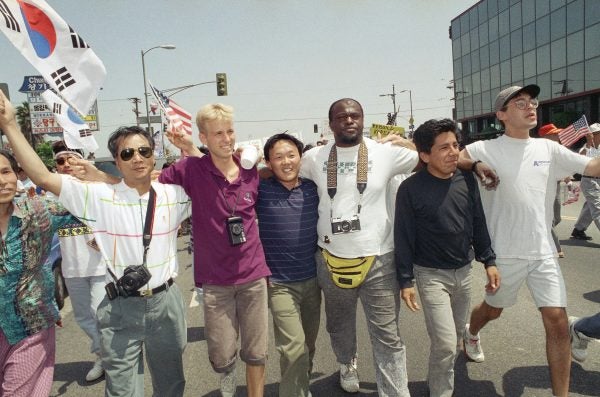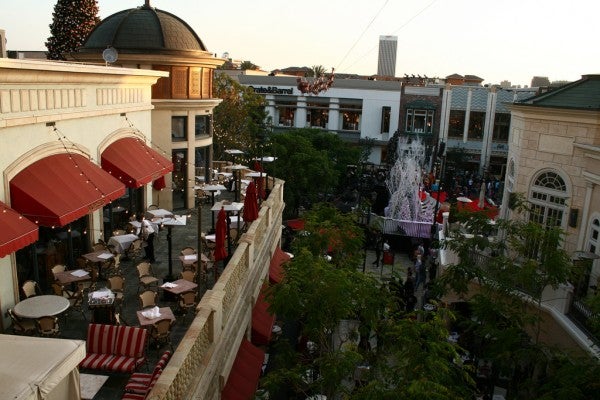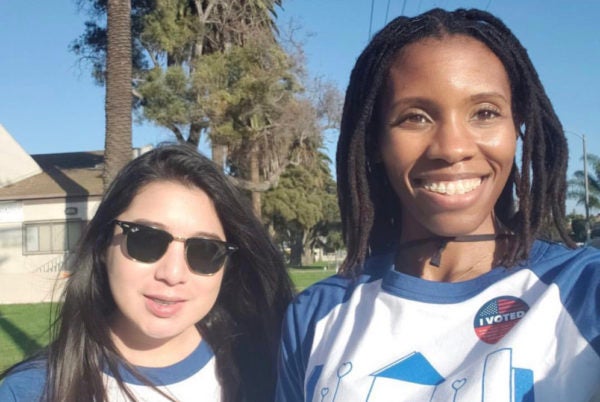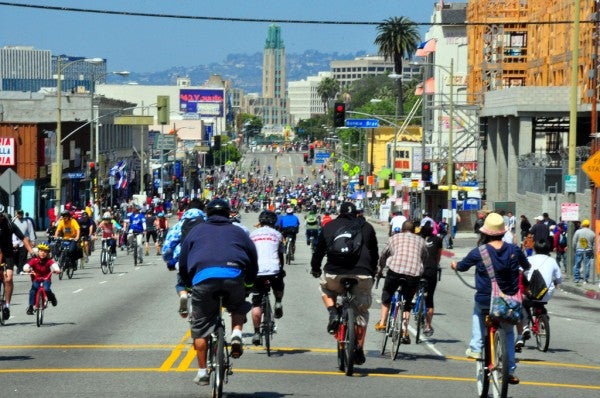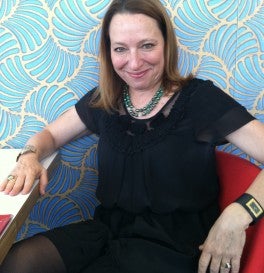
Venue
Ray’s and Stark Bar5905 Wilshire Boulevard
Los Angeles, CA
The Tab
(1) Arnold Palmer(1) Diet Coke
(2) farro salads
————————–
$39.79 + tip
I’m late meeting Donna Bojarsky for lunch at Ray’s and Stark Bar, the restaurant in the courtyard of the Los Angeles County Museum of Art. She’s waiting for me—until she’s not. She just needs a minute. Michael Govan, LACMA’s director and CEO, is at a table nearby. She dips in, they talk, and then she’s back. We’re inside the Renzo Piano-designed glass dining room, the sun streams in, people eat their chopped salads, and I expect to see a celebrity stroll up and grab a seat in one of the mid-century-style red chairs next to us. How L.A.—except, not really.
 “It’s very New York for L.A.,” Bojarsky tells me, explaining why she likes the restaurant. “It’s a glorious thing to be in an artistic space that’s sort of open and cool and imaginative.”
“It’s very New York for L.A.,” Bojarsky tells me, explaining why she likes the restaurant. “It’s a glorious thing to be in an artistic space that’s sort of open and cool and imaginative.”
I want to talk to Bojarsky about why the people of L.A. don’t give back to Los Angeles—and about what they do care about. She’s made a career working out both sides of this knot. Right now, she runs a salon series, the Foreign Policy Roundtable, which brings entertainment higher-ups together around world issues; she’s an editorial consultant for Los Angeles magazine and their CityThink platform on the future of L.A.; and she advises broadcasting entrepreneur Norman J. Pattiz on his work with the Academy of Music at Hamilton High School—he funded a new auditorium—and the University of California, where he is a regent.
For Bojarsky, being part of the city’s civic culture is a no-brainer. At 8, she was handing out buttons for Robert F. Kennedy outside Nate ’n’ Al’s in Beverly Hills. She otherwise missed the activism of the 1960s, but Bojarsky tells me that she and her friends “were raised to believe in tikkun olam”—the Hebrew phrase that means “repair the world.” She and a friend, as kids, dreamed of being nonprofit lawyers in Carmel—and living in a one-bedroom rat-infested hovel there.
“That was the environment I grew up in,” says Bojarsky, remembering fights on the playground after Bobby Kennedy’s assassination over whether you were for Hubert Humphrey or Eugene McCarthy.
Bojarsky’s L.A. roots run deep, and she perceives her hometown through her parents’ dual lenses: gratitude (love, really) and loyalty to her tribes. Her mother came to Los Angeles after surviving the Holocaust; her father was born in Boyle Heights. He raised his family in Beverly Hills, and the extended family lived in Hollywood, where they all attended synagogue.
From her mother, Bojarsky absorbed a gratitude to California, the place that took her in. From her father, she learned to be tribal. When it came to rooting for sports teams, he had a hierarchy: Dodgers, Rams, UCLA. Your home team, then your state. Bojarsky says she always rooted for the Giants in the World Series because they were a California team.
Bojarsky does spend a lot of time on the East Coast, in New York, and she attended Brandeis University, in Massachusetts. But after a stint in Washington with the Senate Rules Committee in the early 1980s, she returned to California (first to work for Democratic State Assemblyman Richard Katz in the northeast San Fernando Valley) and has mostly stayed put.
She loves the non-hierarchical nature of her hometown, the frontier spirit she sees when she looks at the Hollywood Hills. No one cares who your parents are here: “If you can put it together for a BMW, you’re in.”
But despite her affection for the egalitarian nature of L.A., Bojarsky is a firm believer in the power of those at the top to set a tone, communicate, and move people. After working for Katz, she worked under Mayor Tom Bradley, becoming interested in the notion of “a caretaker of a polity”; she’s drawn more to executive rather than legislative positions.
Bojarsky recalls that under Bradley, a “committee of 25” led L.A.’s civic elite. And while she isn’t nostalgic for this all-white, all-male group, she speculates that an analogous present-day entity, a more diverse and representative “committee of 100,” might be good for the city.
“If you back up every problem we have, it backs up to the lack of a robust, competitive, effective civic leadership,” she continues. She starts slowly, then builds momentum, explaining what a real civic elite might do for Los Angeles: build a fine children’s museum and a better zoo, promote more successful public architecture, and provide greater support for public education. A real civic elite could push back against labor. A real civic elite could end transportation stalemates like the fight over the subway in Beverly Hills. A real civic elite would not allow a Pershing Square. It takes Bojarsky a few minutes to run down this list, and it’s clear the issue of creating a more engaged elite is never far from her mind.
Bojarsky’s part in building that elite was starting the New Leaders Project, a civic training program for young Jewish leaders in Los Angeles affiliated with the Jewish Federation. (Two tribes with one stone!) She is also the co-founder of L.A. Works, a nonprofit devoted to fostering community service.
Bojarsky is trying to change the fact that L.A. is an underperforming city when it comes to philanthropy and volunteerism. But it’s an uphill battle, she explains. Los Angeles, for one, is a siloed city. You can go to a Hollywood dinner party, and not only is everyone in the entertainment industry; they’re in either features or television. The A-list television writers of drama, Bojarsky recently discovered, don’t know the A-list comedy scribes. The divides are geographic, too. People who live on the Westside want to be players on the Westside. They don’t care about downtown. Plus, good weather has the power to make us forget that we’re all in this together, with the exception of the occasional earthquake or fire. (“Weather”—a blackout, a storm—“makes you deal with your fellow men,” she explains.)
We commiserate over how slow people who move to Los Angeles are to adopt it as home, and I think of how my husband still clings to his home-state driver’s license after living here for three and a half years. “People believe somehow that they’re here temporarily, which is funny, because they’re not,” says Bojarsky. You don’t grow up in Los Angeles and move to Cleveland; you don’t leave Los Angeles, generally, unless you’re heading to New York. And if you have kids here, you are staying. Yet you’re still unlikely to engage, or join, or care.
As a result, decisions in L.A. are being left to too few players; problems are only seen after the fact rather than being examined, critiqued, and publicized, as they are in other places. “This city,” Bojarsky tells me, “has untold potential to be interesting, fun—and to be so much more.”
So, what do we do about our civic deficit?
“We have to seduce people into a love of Los Angeles that will be meaningful and turn into some sort of participation and leadership,” she says.
Bojarsky’s words resonate with me. I’ve been in L.A. for just two years, and when I tell people I “love it,” they react with horror or shock. You need look no further than the turnout every election day for evidence of the low level of engagement. I’ve been indoctrinated by a few natives who are true boosters of the place, but not everyone is lucky enough to have those folks in their lives. Bojarsky tells me she’s tried 10 different ways, as an adult here, to build up the love L.A. so desperately needs.
She points to Los Angeles magazine’s “Get L.A.” contest as a particularly successful venture in getting people to consider more deeply their connection to the city. The magazine asked people to submit 3-minute videos explaining what they love or hate about L.A. The purpose, Bojarsky says, was to make people think about L.A.—maybe for just three minutes, maybe for a half-hour, maybe for two weeks. Almost every video, it turned out, had driving in it. The secret truth, said Bojarsky, who grew up on weekend car rides, is that everyone in L.A. likes to drive.
I beg to differ; driving seems to be the one thing about L.A. that I just can’t come to terms with. But I’m liking the fact that Bojarsky and I have both ordered the same thing: the farro salad. The sun is still shining, Michael Govan is still making his rounds, and my lunch is delicious. What’s not to love about this town?




